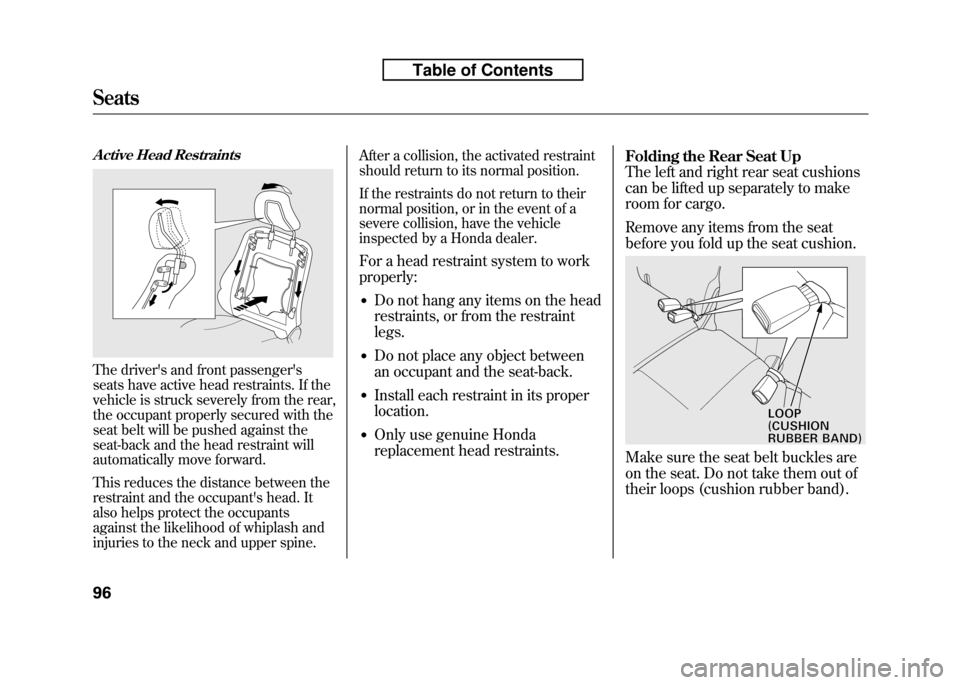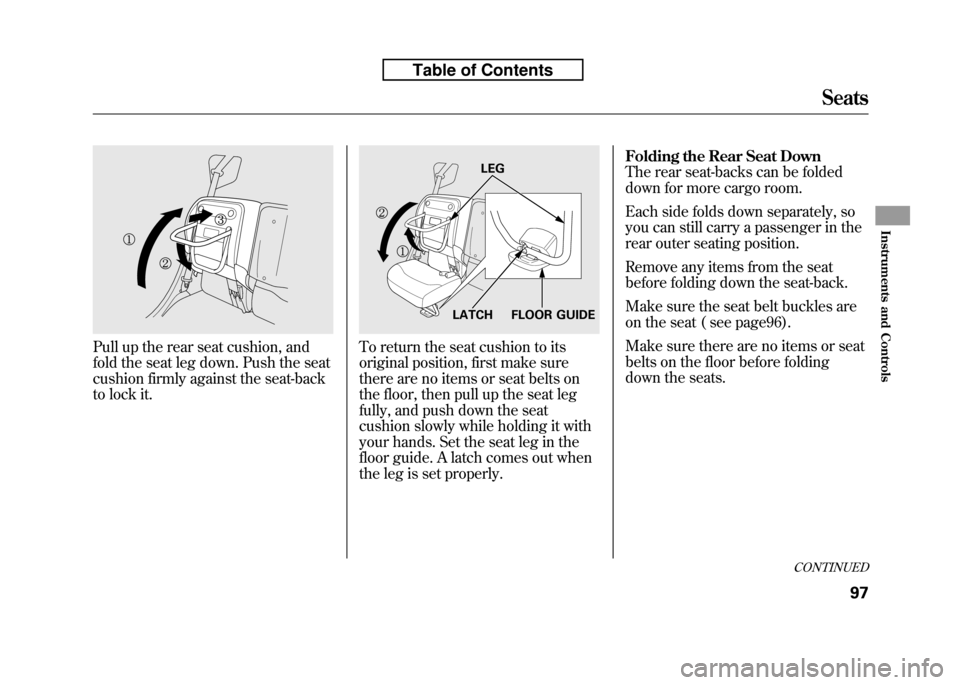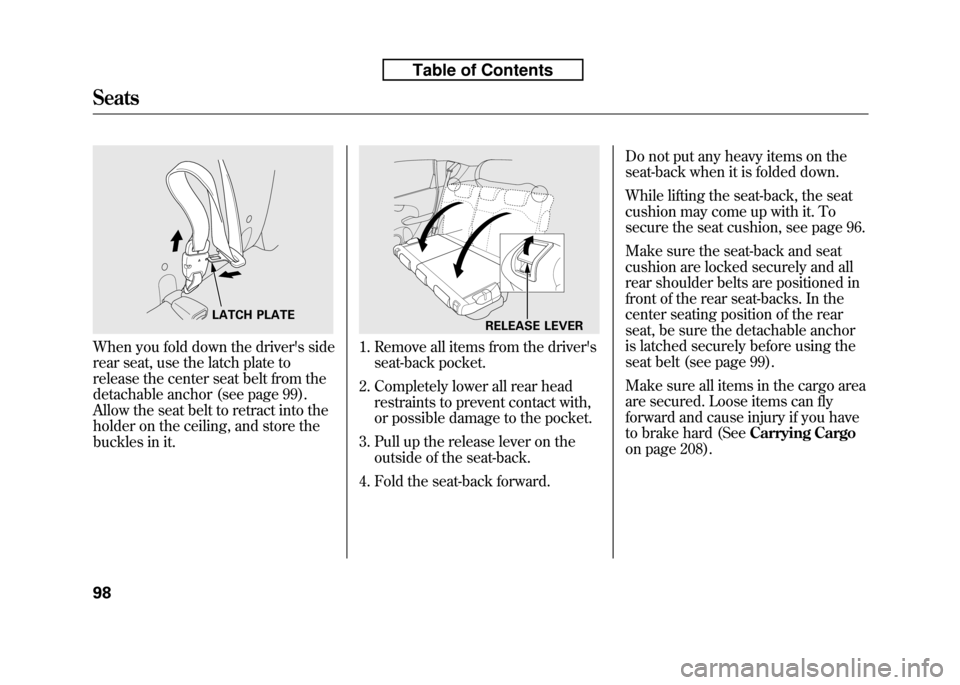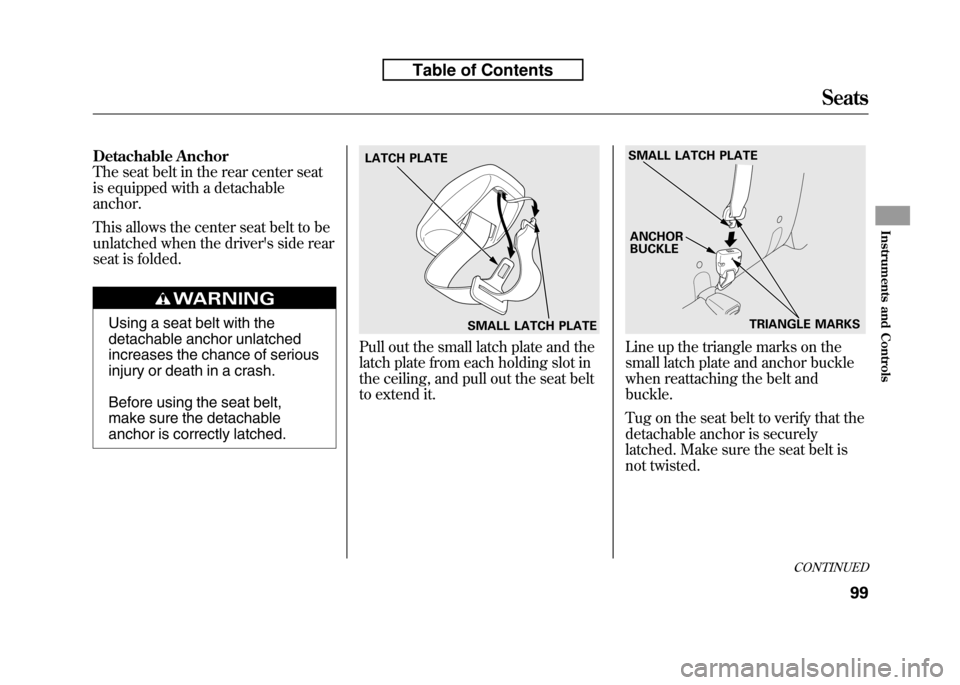2010 HONDA FIT fold seats
[x] Cancel search: fold seatsPage 33 of 351

Additional Safety Precautions●
Never let passengers ride in the
cargo area or on top of a folded-
down back seat.
If they do, they
could be very seriously injured in a crash.
●
Never let passengers ride in the area in front of a folded-up rearseat or on top of a folded-down rear
seat.
If they do, they could be very
seriously injured in a crash.
●
Passengers should not stand up or change seats while the vehicle is
moving.
A passenger who is not
wearing a seat belt during a crash
or emergency stop can be thrown
against the inside of the vehicle,
against other occupants, or out of
the vehicle.
●
Two people should never use the same seat belt.
If they do, they
could be very seriously injured in acrash. ●
Do not put any accessories on seat
belts.
Devices intended to improve
occupant comfort or reposition the
shoulder part of a seat belt can
reduce the protective capability of
the belt and increase the chance of
serious injury in a crash.
●
Do not place hard or sharp objects between yourself and a front
airbag.
Carrying hard or sharp
objects on your lap, or driving with
a pipe or other sharp object in your
mouth, can result in injuries if your
front airbag inflates.
●
Keep your hands and arms away from the airbag covers.
If your
hands or arms are close to an
airbag cover, they could be injured
if the airbag inflates. ●
Do not attach or place objects on
the front airbag covers.
Objects on
the covers marked ‘‘SRS AIRBAG ’’
could interfere with the proper
operation of the airbags or be
propelled inside the vehicle and
hurt someone if the airbags inflate.
●
Do not attach hard objects on or near a door.
If a side airbag or a
side curtain airbag inflates, a cup
holder or other hard object
attached on or near the door could
be propelled inside the vehicle and
hurt someone.
●
Do not cover or replace front seat- back covers without consulting
your dealer.
Improperly replacing
or covering front seat-back covers
can prevent your side airbags from
inflating during a side impact.
Protecting Adults and Teens
17
Driver and Passenger Safety
Table of Contents
Page 112 of 351

Active Head Restraints
The driver's and front passenger's
seats have active head restraints. If the
vehicle is struck severely from the rear,
the occupant properly secured with the
seat belt will be pushed against the
seat-back and the head restraint will
automatically move forward.
This reduces the distance between the
restraint and the occupant's head. It
also helps protect the occupants
against the likelihood of whiplash and
injuries to the neck and upper spine.After a collision, the activated restraint
should return to its normal position.
If the restraints do not return to their
normal position, or in the event of a
severe collision, have the vehicle
inspected by a Honda dealer.
For a head restraint system to work properly: ● Do not hang any items on the head
restraints, or from the restraintlegs.
● Do not place any object between
an occupant and the seat-back.
● Install each restraint in its properlocation.
● Only use genuine Honda
replacement head restraints. Folding the Rear Seat Up
The left and right rear seat cushions
can be lifted up separately to make
room for cargo.
Remove any items from the seat
before you fold up the seat cushion.
Make sure the seat belt buckles are
on the seat. Do not take them out of
their loops (cushion rubber band).
LOOP(CUSHIONRUBBERBAND)
Seats
96
Table of Contents
Page 113 of 351

Pull up the rear seat cushion, and
fold the seat leg down. Push the seat
cushion firmly against the seat-back
to lock it.To return the seat cushion to its
original position, first make sure
there are no items or seat belts on
the floor, then pull up the seat leg
fully, and push down the seat
cushion slowly while holding it with
your hands. Set the seat leg in the
floor guide. A latch comes out when
the leg is set properly.Folding the Rear Seat Down
The rear seat-backs can be folded
down for more cargo room.
Each side folds down separately, so
you can still carry a passenger in the
rear outer seating position.
Remove any items from the seat
before folding down the seat-back.
Make sure the seat belt buckles are
on the seat ( see page96).
Make sure there are no items or seat
belts on the floor before folding
down the seats.
FLOOR GUIDE
LEG
LATCH
CONTINUED
Seats
97
Instruments and Controls
Table of Contents
Page 114 of 351

When you fold down the driver's side
rear seat, use the latch plate to
release the center seat belt from the
detachable anchor (see page 99).
Allow the seat belt to retract into the
holder on the ceiling, and store the
buckles in it.1. Remove all items from the driver'sseat-back pocket.
2. Completely lower all rear head restraints to prevent contact with,
or possible damage to the pocket.
3. Pull up the release lever on the outside of the seat-back.
4. Fold the seat-back forward. Do not put any heavy items on the
seat-back when it is folded down.
While lifting the seat-back, the seat
cushion may come up with it. To
secure the seat cushion, see page 96.
Make sure the seat-back and seat
cushion are locked securely and all
rear shoulder belts are positioned in
front of the rear seat-backs. In the
center seating position of the rear
seat, be sure the detachable anchor
is latched securely before using the
seat belt (see page 99).
Make sure all items in the cargo area
are secured. Loose items can fly
forward and cause injury if you have
to brake hard (See
Carrying Cargo
on page 208).
LATCH PLATERELEASE LEVER
Seats
98
Table of Contents
Page 115 of 351

Detachable Anchor
The seat belt in the rear center seat
is equipped with a detachableanchor.
This allows the center seat belt to be
unlatched when the driver's side rear
seat is folded.
Using a seat belt with the
detachable anchor unlatched
increases the chance of serious
injury or death in a crash.
Before using the seat belt,
make sure the detachable
anchor is correctly latched.
Pull out the small latch plate and the
latch plate from each holding slot in
the ceiling, and pull out the seat belt
to extend it.Line up the triangle marks on the
small latch plate and anchor buckle
when reattaching the belt andbuckle.
Tug on the seat belt to verify that the
detachable anchor is securely
latched. Make sure the seat belt is
not twisted.
SMALL LATCH PLATE
LATCH PLATE
SMALL LATCH PLATE
TRIANGLE MARKS
ANCHOR BUCKLE
CONTINUED
Seats
99
Instruments and Controls
Table of Contents
Page 223 of 351

Your vehicle has several convenient
storage areas:● Upper glove box
● Lower glove box
● Front door pockets
● Seat-back pocket (if equipped)
● Center pocket
● Cargo area side pocket
● Cargo area, including the rear
seats when folded up or down.
● Seat under box
● Cargo floor box (all canadian
models with automatic transmission)
However, carrying too much cargo,
or improperly storing it, can affect
your vehicle's handling, stability,
stopping distance, tires, and make it
unsafe. Before carrying any type of
cargo, be sure to read the followingpages.
REAR SIDE POCKET
(RIGHT SIDE)
CARGO FLOOR BOX*
2
FRONT DOOR POCKETS
SEAT-BACK POCKET*
1
SEAT UNDER BOX CENTER POCKET
CARGO AREA
LOWER GLOVE BOX
ꭧ 1: If equipped
ꭧ 2: All Canadian models with automatic transmission UPPER GLOVE BOX
Carrying Cargo
208
Table of Contents
Page 226 of 351

Carrying Cargo in the Passenger Compartment● Store or secure all items that could
be thrown around and hurt
someone during a crash.
● Be sure items placed on the floor
behind the front seats cannot roll
under the seats and interfere with
the driver's ability to operate the
pedals, the proper operation of the
seats, or proper operation of the
sensors under the seats.
● Keep the upper and lower glove
boxes closed while driving. If it is
open, a passenger could injure
their knees during a crash or
sudden stop. ●
If you fold the rear seats up or
down, tie down items that could be
thrown about the vehicle during a
crash or sudden stop. Also, keep
all cargo below the bottom of the
windows. If it is higher, it could
interfere with the proper operation
of the side curtain airbags. Carrying Cargo in the Cargo Area
● Distribute cargo evenly on the
floor of the cargo area, placing the
heaviest items on the bottom and
as far forward as possible. Tie
down items that could be thrown
about the vehicle during a crash or
sudden stop.
● Do not stack items higher than the
back of the rear seats. They can
block your view and be thrown
around the vehicle during a crash.
● If you carry large items that
prevent you from closing the
tailgate, exhaust gas can enter the
passenger area. To avoid the
possibility of carbon monoxide
poisoning, follow the instructions
on page 53.
CONTINUED
Carrying Cargo
211
Before Driving
Table of Contents